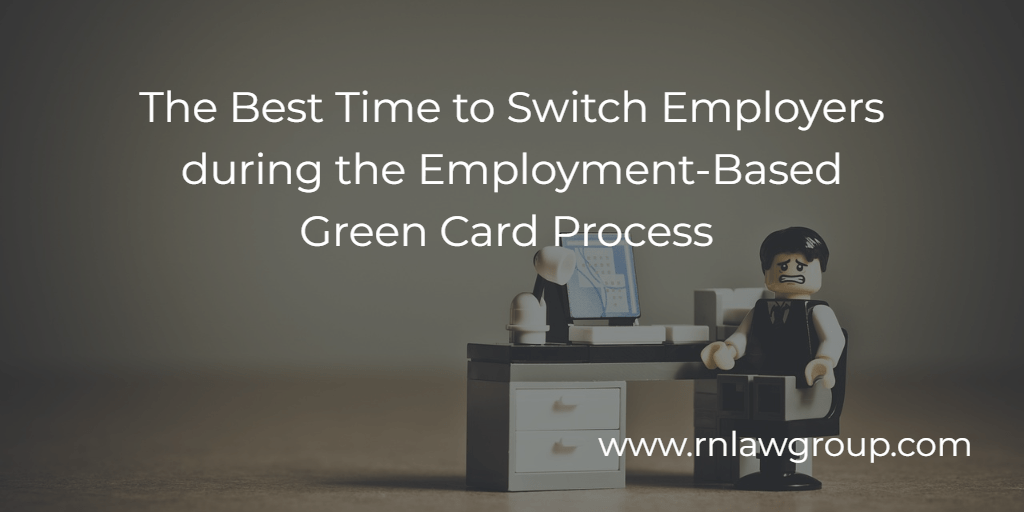
The Best Time to Switch Employers during the Employment-Based Green Card Process
Oftentimes, beneficiaries wonder when is the best time to switch employers during their Green Card process. When being sponsored for the employment-based Green Card process, the process is tied to the employer. Therefore, if the beneficiary changes employers, then the process generally needs to begin anew.
The Employment-based Green Card process has three stages:
- PERM Labor Certification
- I-140, Immigrant Petition for Alien Worker
- I-485, Application to Register Permanent Residence or Adjust Status
The best time to switch employers (prior filing the I-485) is after the second stage of the employment-based Green Card process, once the beneficiary has an approved I-140.
Why it is best to wait after receiving your approved I-140 to switch employers?
Once the I-140 is approved, the priority date (the date the PERM Labor Certification was submitted) is “locked-in.” Once the I-140 has been approved for more than 180 days, then the approved I-140 can never be revoked from the beneficiary. This remains true even when the employer withdraws the I-140. Therefore, it is best to wait till the I-140 has been approved for more than 180 days, so that the beneficiary has the perpetual benefit of using it.
Importance of the Priority Date
The priority date dictates the date the beneficiary may file or may receive final action on their I-485. This is especially important for beneficiaries whose country of birth have severe backlog, such as: China, India, Mexico, and the Philippines.
Also, it is important to note that the priority date may be ported to any employment-based preference category (EB-1, EB-2, EB-3) the beneficiary qualifies for, regardless of the category the priority date was initially obtained under.
What is the point of using a prior or withdrawn I-140?
Even though the beneficiary no longer is being sponsored by the employer listed on the I-140 or the I-140 has been withdrawn by the employer; if the I-140 has been approved for more than 180 days, then the beneficiary has the perpetual benefit of using the I-140 for the purpose of extending their H-1B beyond the 6th year limit.
Next Steps for New Employer
Before or after the beneficiary obtains their H-1B with the new employer, the employer may start the employment-based Green Card process. To do so, the new employer will need to begin at stage I, the PERM Labor Certification. Although, the process will need to begin again for the beneficiary, one benefit the beneficiary will have is being able to port their I-140 priority date at the time of filing the I-140 Petition. By porting the priority date, USCIS will honor the beneficiary’s previous priority date. This benefit allows for the beneficiary to maintain their place in line for the Green Card while starting a new Green Card process with their new employer.
In conclusion, the best time for a beneficiary to switch employers during the employment-based Green Card process (prior filing the I-485) is once the beneficiary has obtained an approved I-140, which has been approved for more than 180 days. At this point, the beneficiary will have the least amount of disruption during the processing of their Green Card when they seek to switch employers.
If you seek assistance with your Green Card process, please schedule a consultation with one of our immigration attorneys.
Reddy & Neumann has been serving the business community for over 25 years and is Houston’s largest immigration law firm focused solely on U.S. Employment-based immigration. We work with both employers and their employees, helping them navigate the immigration process quickly and cost-effectively.
By: Ruth Garbanzo
Ruth Garbanzo assists clients in the beginning stages of their green card process in the Perm Labor Certification Department as well as the final stages of their green card process in the Adjustment of Status Department. Throughout our client’s green card journey, Ruth strives to provide diligent service to each client from start to finish.
Ruth began her career in law as a Legal Assistant in New York, where she worked on employment-based cases (TN, H1B, L, EB-5) and family-based cases (AOS, K-1 and N-400). As a law student at South Texas College of Law Houston, Ruth further pursued her interest in the field of immigration law through course and clinic work, including the General and Advanced Immigration Clinics. In the Advanced Immigration Clinic, Ruth worked on deportation defense cases and gained exposure of immigration court proceedings. Further, as the Pro Bono Ambassador and Vice President of the Hispanic Law Student Association, Ruth focused the Association’s initiatives towards Pro Bono opportunities in the area of immigration law. As a law student, Ruth interned at a non-profit organization, where she worked on T, U, VAWA and DACA cases.

